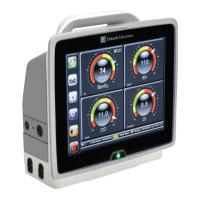HemoSphere Advanced Monitor 10 Monitoring with the HemoSphere Pressure Cable
135
*NOTE The Hypotension Probability Indicator (HPI) parameter [P(↓BP)] is an advanced
feature that must be activated using a FloTrac IQ sensor connected to a radial arterial
catheter. See Acumen Hypotension Probability Indicator Software Feature on page 150 for more
information.
WARNING Do not resterilize or reuse any FloTrac sensor, FloTrac IQ sensor, TruWave transducer,
or catheter; refer to the catheter’s “directions for use”.
Do not use a FloTrac sensor, FloTrac IQ sensor, TruWave transducer, or catheter that
is wet, damaged, or that has exposed electrical contacts.
Refer to the directions provided with each accessory for specific instructions on
placement and use, and for relevant WARNINGS, CAUTIONS, and specifications.
When the pressure cable is not in use, protect the exposed cable connector from fluid.
Moisture within the connector may result in the cable malfunctioning or in inaccurate
pressure readings.
CAUTION Do not use any FloTrac sensor or TruWave transducer past its labeled “Use By Date.”
Products used beyond this date may have compromised transducer or tubing perfor-
mance, or compromised sterility.
10.2 Monitoring Mode Selection
The primary monitoring mode for the HemoSphere pressure cable is FloTrac sensor monitoring mode. The
monitoring mode appears at the center of the information bar. The pressure cable can also be used to collect
pulmonary artery pressure (PAP) data while in Swan-Ganz module monitoring mode. See Select Monitoring
Mode on page 80 for more information on switching between monitoring modes.
10.3 FloTrac Sensor Monitoring
The HemoSphere pressure cable serves as an Edwards FloTrac sensor connecting cable for the HemoSphere
advanced monitoring platform. The HemoSphere pressure cable with a connected FloTrac or FloTrac IQ
sensor uses the patient’s existing arterial pressure waveform to continuously measure cardiac output (FloTrac
arterial pressure autocalibrated cardiac output [FT-CO]). With the input of patient height, weight, age, and
gender, a specific vascular compliance is determined. The FloTrac algorithm’s automatic vascular tone
adjustment recognizes and adjusts for changes in vascular resistance and compliance. Cardiac output is
displayed on a continuous basis by multiplying the pulse rate and calculated stroke volume as determined
from the pressure waveform. The FloTrac or FloTrac IQ sensor measures variations of arterial pressure
proportional to stroke volume.
The HemoSphere pressure cable and FloTrac or FloTrac IQ sensor, use the patient’s existing arterial
pressure waveform to continuously measure stroke volume variation (SVV). SVV is a sensitive indicator of
the patient’s preload responsiveness when the patient is 100% mechanically ventilated with a fixed rate and
tidal volume, and no spontaneous breaths. SVV is always used best in conjunction with stroke volume or
cardiac output assessment.
Status = Released Printed Date: 2018-01-16 Released Date: 2017-09-14

